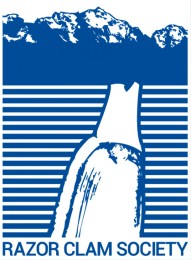Press Release
RE: State of the Clam Address
Olympia- The 2015-2016 razor clamming season in Washington State saw some early challenges, but gathered momentum in what became a fantastic season rivaling the last. The season was dramatically shortened due to a very late season opening around Christmas caused by high levels of toxicity in the clams. Grayland / Twin Harbors remained closed all season, carrying over from an early closure of the previous season due to persistent and high levels of toxicity in the clams on that beach.
However, the 2016-2017 season looks like it will be bountiful. Washington Department of Fish & Wildlife (WDFW) has just announced a mid-October season opening. That’s great news for us razor clammers eager to get out on the beaches. And, according to WDFW, the clam population numbers look stronger than ever.
Recreational razor clamming remains one of the most popular licensed outdoor recreational activities in Washington State. According to WDFW, over 59,000 razor clamming specific licenses were sold in the State this season. That number trended lower due to the late opening. The previous season, which was also cut short, saw the sale of over 75,000 licenses. The season before that, 80,000 licenses were sold.
The number of trips made for license holders to dig razor clams characterizes just how dedicated people are to this sport. During the course of the past seasons, 327,544 trips were made by razor clammers to the beaches to dig. During the 2014-2015 season 451,046 trips, and for the 2013-2014 season, 418,675 trips were made.
Recreational razor clamming enjoys a long season and broad and enthusiastic participation. A normal razor clamming season extends from late September or early October through mid to late May. The demographics of razor clammers are wide-ranging; from the very young to the very old, people from all walks of life, diverse backgrounds and geographies. Entire multi-generational families dig razor clams together. It is an all-inclusive outdoor activity.
Razor clamming is an easy activity to become involved in. All a recreational clammer needs is a valid harvest license (if 15 years of age or older) and an individual container, usually a small net, to hold the clams in. Clammers are limited to the first 15 clams they dig. While digging clams by hand is possible, it is easier to use a small shovel or clam gun.
During the course of our first full year of operations, the Razor Clam Society has participated in seven well-attended festival and fairs. We raised some funds through a crowdfunding campaign, and received numerous small donations from the public we interacted with. We also began an effort to collect the requisite 3,500 names necessary to seek the issuance of a Razor Clam license plate through the Washington State Department of Licensing. We recently attended, and assisted in, the Washington Department of Fish & Wildlife annual razor clam stock assessment. Video of those activities were posted on our website and social media. Over the course of 3 days the videos had been viewed more than 4,000 times. People are excited about and interested in razor clamming. And finally, the Razor Clam Society became a partner in the Washington State Governor’s Shellfish Initiative.
—————
About the Razor Clam Society:
The Razor Clam Society is a Washington State non-profit charitable organization established in October 2015 and registered with the State’s combined fund drive. We are also registered as an official 501(c)(3) non-profit charitable organization with the IRS.
The Razor Clam Society is dedicated to promoting recreational razor clamming. Our aim is to build a highly engaged community of razor clammers to ensure the viability of razor clamming for the enjoyment of future generations. Our efforts focus on four things: 1) conservation; 2) representing the clamming community to local and state government; 3) connecting local economies to the broader clamming community; and 4) highlighting how much fun responsible clamming practices can be.
